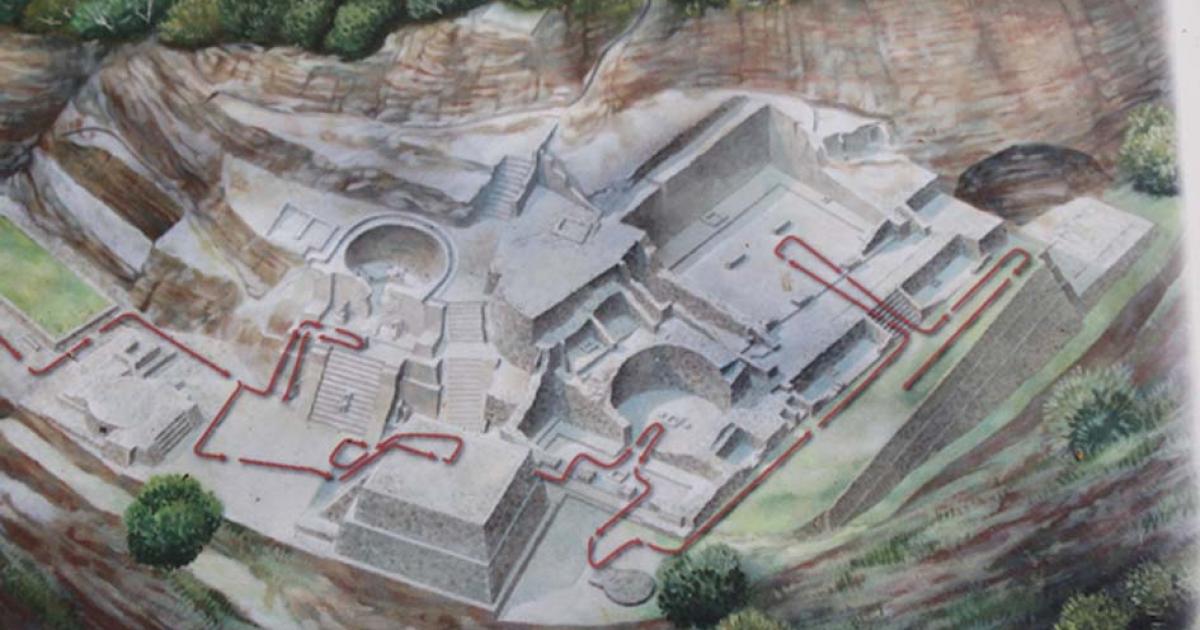
The Megalithic Temple of Malinalco: Could these Magnificent and Complex Rock-Cut Structures Actually Pre-Date the Aztecs?
The little town of Malinalco lies at the margins of the Valley of Tepoztlan, some 115 kilometers (71 miles) to the southwest of Mexico City. Since Prehispanic times, its name has been associated with magic and sorcery: Malinalxochitl, goddess of snakes was worshipped on the Cerro de los Idolos, a hill overlooking the entire valley and the town below. In 1470, a temple was built on the hill as a sanctuary and a center of initiation for the military elite of the Aztec empire, the Eagle and Jaguar warriors. The origins of the site may, however, date back hundreds or even thousands of years earlier.
The temple of the Eagle Warriors, known locally as Cuauhtinchan, is a unique monolithic structure that has no equal in all of Mesoamerica. It consists of a number of chambers dug out of the living rock and a monumental stepped pyramid also carved out of the cliff face. The main temple is perched on a ledge, which rises 125 meters (410 feet) above the town. A remote and inaccessible location, it was only discovered in 1933 and explored by Mexican archaeologist José García Payón in 1935.
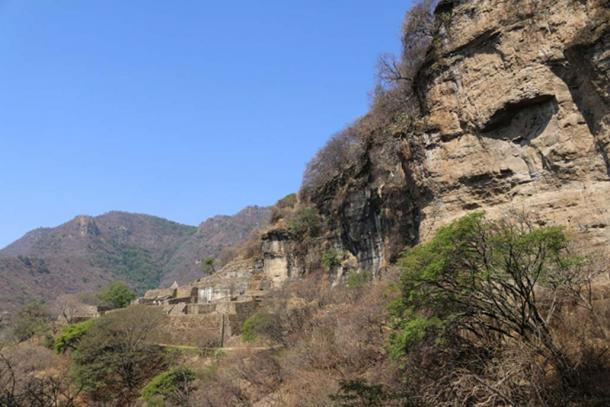
A view of the main ceremonial center of Malinalco from the access trail to the East, undercutting some nearly vertical cliffs. The natural characteristics of the site would have made it an almost impregnable fortress. (© Marco Vigato)
Incredible Chambers and Architecture
The site is reached by a modern stairway of over 420 steps. The original access might have been by a similar pathway, as remains of steps and stairs cut into the rock are still visible at places.

View of the “House of the Eagles”, the main monolithic temple that dominates the site of Malinalco. The temple is carved in the shape of a three-tiered pyramid with a circular chamber on top. It is speculated that the conical roof could have served as a “zenith-tube” for astronomical observations. (© Marco Vigato)
Upon reaching the level of the first rock ledge where the main temple is located, one encounters a large rock-cut trench that was clearly left unfinished. From there, a narrow pathway gives access to a small plaza closed on three sides by ceremonial structures and platforms. On the north side is the Cuahcalli or “House of the Eagles”, in the shape of a stepped pyramid entirely dug out of the living rock. A stairway gives access to a spacious, circular, rock-cut chamber with benches in the shape of mythological animals, eagles, and jaguars. To the east of it is a ceremonial pyramid built in the typical Aztec style of small volcanic stones cemented together; while to the West of the plaza stands a smaller, circular altar dedicated to Ehecatl, the God of Wind.
Further to the east, on a continuation of the same rock ledge that was artificially enlarged by means of massive retaining terraces, are a number of chambers and circular structures. Their workmanship appears rather crude in comparison to the precision of the monolithic architecture and is typical of the Aztec technique of construction employing smaller cemented stones.
By far the largest structure on the site is an immense rock-cut chamber, with a front of over 20 meters (65 feet). This has been entirely cut in the living rock with astonishing precision, partially cutting some earlier trenches and aqueducts that are still visible in its upper portions. These aqueducts continue in the form of narrow stone conduits further along the cliff face until reaching some sort of reservoir.

View of the “House of the Eagles”, the main monolithic temple that dominates the site of Malinalco. (© Marco Vigato)
The House of the Eagles: Where Blood Was Spilled
The House of the Eagles is a unique example of monolithic architecture. It was carved directly into the hillside without the aid of metal tools, as these were not known to the Aztecs. It is almost incredible to imagine that such a structure and all its intricate decoration could be carved with simple stone tools.
The rock was carved in the shape of a three-tiered pyramid rising from a high podium, which was similarly carved in the living rock. A single monolithic stairway leads to the top, flanked by balustrades on both sides and seated jaguar statues that might have served as standard-bearers, now badly defaced.
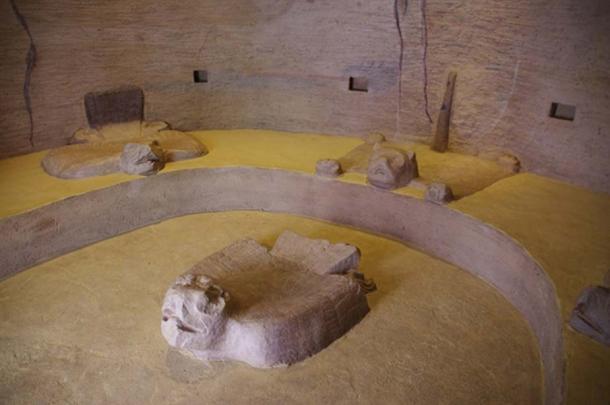
View of the reconstructed bas-reliefs and rock-cut benches inside the “House of the Eagles”. Three seats sculpted in the shape of a jaguar skin and eagles with sprayed wings surround a central altar also in the shape of an eagle. A circular hole in the floor would have served to collect blood or other liquids from the altar. It is also possible that the circular hole, filled with water, could have served as a water mirror for solar or astronomical observations. (© Marco Vigato)
The temple on top is similarly flanked by a pair of statues to each side of the entrance. The one to the right, probably depicting a warrior but now lacking its upper part, rests on a serpent head; while the one to the left of the entrance sits on what appears to be a carved drum pierced by a number of drilled holes. The doorway itself was meant to represent the open jaws of the Earth monster, whose bifurcated tongue flops out to form a step leading into the temple.
- The Rome of America: What Lies Under Teotihuacan? – The Real City of the Gods
- Descending into the Underworld of Teotihuacan: Labyrinthine Tunnels and Rivers of Mercury
- Art of an Empire: The Imagination, Creativity and Craftsmanship of the Aztecs
The main chamber is circular in shape, with a bench running around the perimeter. The workmanship of this section is extraordinarily precise, with a number of high relief figures in the form of eagles and jaguar skins carved upon the bench. An altar in the shape of an eagle stands in the center of the room. That blood was meant to be spilled on this altar is proved by the presence of a channel that drains into a perfectly circular hole drilled through the floor of the chamber.
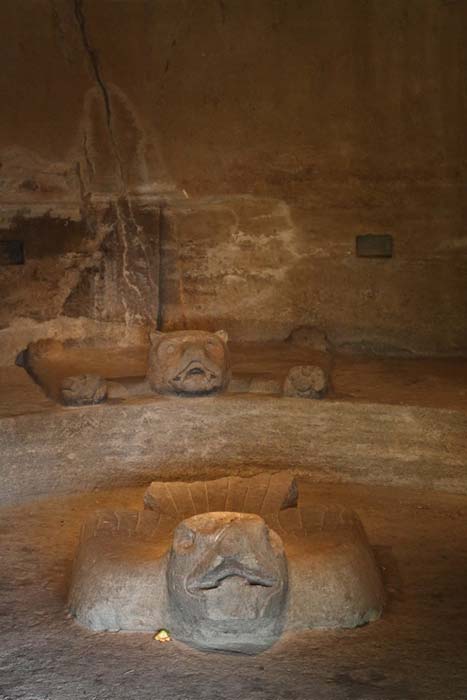
A detail of the main altar and rock benches inside the “House of the Eagles”. Access to this chamber is currently forbidden for preservation of the bas-reliefs. A replica has been installed in the local museum. (© Marco Vigato)
In antiquity, the building would have possessed a conical roof, which has led to speculation that the peculiar shape of the chamber and its roof could have served as a solar observatory, perhaps with the addition of a “zenith” tube – an opening in the roof through which sunlight would pierce the obscurity of the chamber at particular times of the year.
Round Structure with Altar Housed Ceremonies– “Structure III”
Immediately to the east of the house of the eagles, a rock-cut stairway oriented at an angle with the main temple would have led to further platforms above, which have not been excavated nor cleared of vegetation. There is evidence that an earlier ceremonial site might have stood closer to the summit of the hill, dating perhaps to Teotihuacan times. Also, more rock-cut temples and vast caverns are rumored to exist in the still unexplored parts of the Cerro de los Idolos.
A large complex of chambers to the east follow roughly the same plan as that of the House of the Eagles. We find there another circular structure called “Structure III”, which probably served a similar purpose as suggested by the presence of an altar in the middle. The workmanship of this part of the site is typically Aztec. Rather than being cut from the cliff face, the walls of these chambers consist of smaller volcanic rocks cemented together. The walls were also originally stuccoed, for traces of frescoes were discovered during the 1935 excavations by archaeologist José Garcia Payón. The subject of these frescoes, of which only drawings survive, was probably related to the military and initiatic ceremonies that were conducted at the site.

Some of the structures to the East of the main temple, built in the typical Aztec style of construction consisting of small cemented stones, make a stark contrast to the geometric precision of the monolithic structures nearby. (© Marco Vigato)
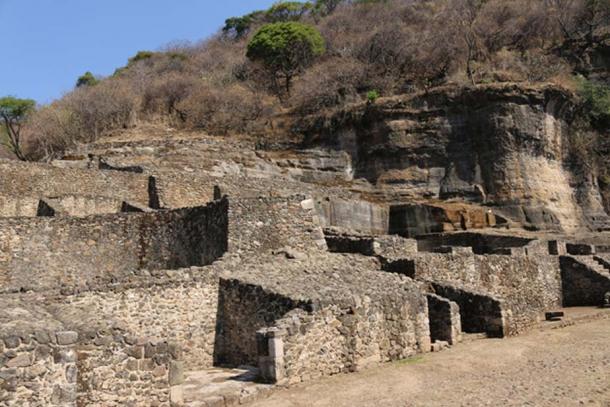
The typical Aztec style of construction consisting of small cemented stones. (© Marco Vigato)
Strange Tools Made the Mysterious Rock-cut chamber – “Structure IV”
The last important structure, called “Structure IV”, is, in fact, an immense rock-cut chamber cut directly out of the cliff face. The chamber is rectangular, measuring nearly 20 meters (65 feet) on its longer side by 10 meters (33 feet) on the shorter side. It is open to the east and has a rock-cut bench running along the perimeter of the walls. A number of pillar bases and a rectangular basin, probably serving as an altar, are also similarly cut from the living rock. The depth of the cut reaches at least five meters (16 feet) on the northern side. In addition, the upper portion of the cliff face appears to have been artificially leveled, perhaps in an even earlier epoch. It is possible that from this chamber alone at least 1,000 cubic meters or 3,000 tons of rock were removed in ancient times! The astonishing precision of the cut, which left a very smooth and remarkably planar rock face, with no visible chisel or other tool marks, suggests the use of tools that would have hardly been available to the Aztecs or any of the other known Mesoamerican civilizations of antiquity.
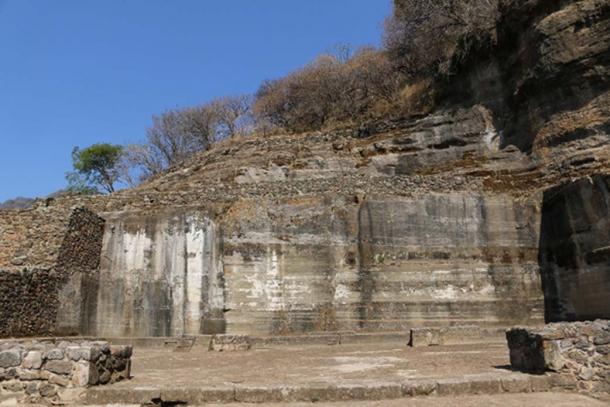
Known as “Structure IV”, this immense rock-cut trench (measuring 20 by 15 meters, 66 by 50 feet) is an extraordinary example of monolithic architecture. Over 1,000 cubic meters of rock were removed in order to carve this chamber out of the cliff face. It is almost impossible to believe that a work of such extent and precision could be completed without the aid of metal tools. (Photos © Marco Vigato)
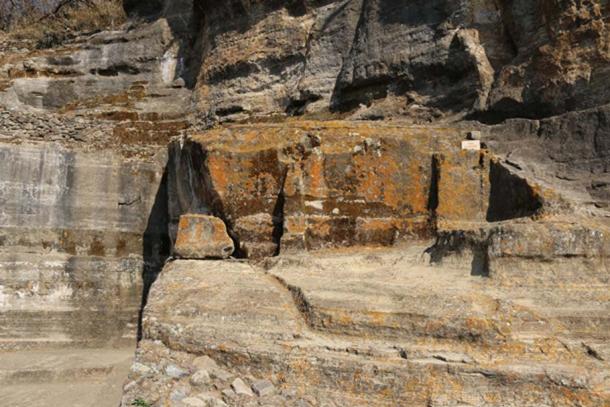
“Structure IV” (© Marco Vigato)
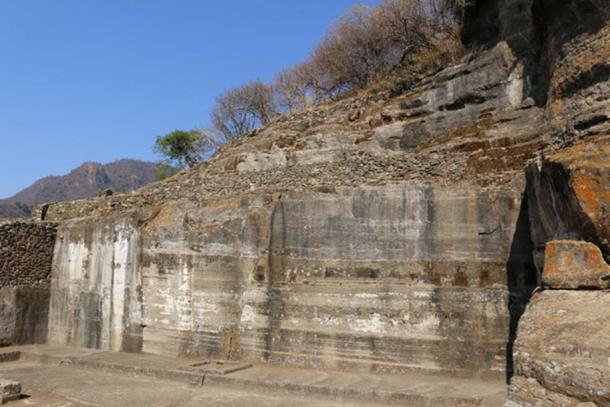
“Structure IV” (© Marco Vigato)
Further to the east of this chamber, on a small rock ledge that was also artificially leveled, a number of interesting rock carvings are visible. They seem to form a kind of double throne, or a small space divided in two by a partition wall, not unlike similar rock carvings found in Peru and at other megalithic sites around the world.
Monolithic Architecture in Mesoamerica
In all of Mesoamerica, a similar style of monolithic architecture is only found among the ruins of Texcoco, which bear a distinct similarity with the rock-cut temples of Malinalco, although on a much smaller scale. As in the case of Malinalco, the perfectly cut and polished stone basins, stairways, and rock-cut chambers of Texcoco exhibit a level of workmanship far in advance of what could have been achieved with simple stone tools. In addition, the significant erosion to which the rock surface has been subjected in both cases is indicative of an antiquity far more remote than the supposed 15th or early 16th century assumed date of the carvings.
- Ancient Sacred Sites Triangularly Aligned by the Footsteps of the Gods
- Newgrange and Saqsayhuaman: Separated at Birth in 3050 BC?
- The Golden Stick: Cuzco’s Divine Foundation Myth and The Scientific Connections
Another point of similarity with the ruins of Texcoco is offered by the presence of rock-cut aqueducts. A number of water channels can be found at Malinalco, particularly on the upper terraces. Their great antiquity is testified by the fact that they appear in some cases to have been cut by later structures and rock-cut trenches.
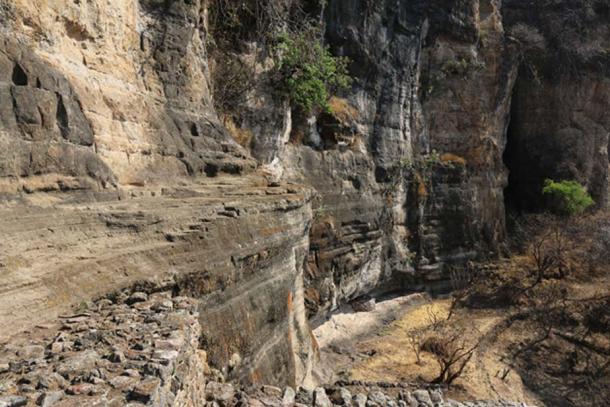
A number of aqueducts and water channels run around the base of the cliff and would have served to drain the rainwater from the upper terraces and the roofs of buildings to the valley below. (© Marco Vigato)
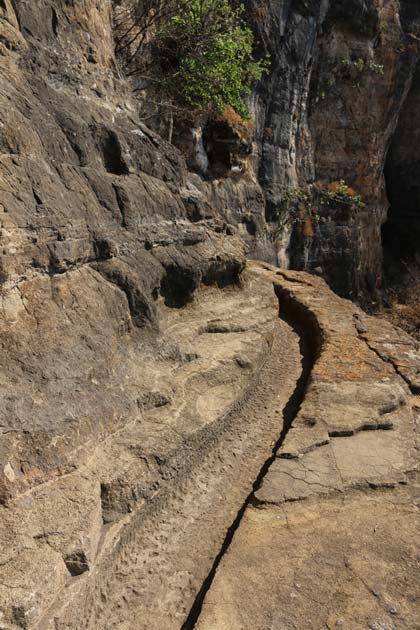
Aqueducts cut into the rock. (© Marco Vigato)

Aqueducts (© Marco Vigato)
Also, a number of monolithic stairways can be found, other than at the main site, at the nearby temple of Tlaloc, which is separated from it by a deep ravine. It is hard to find an explanation for these monolithic stairways, for they end abruptly on the face of the ravine. It is possible though that a circular basin like the one at Texcoco originally existed at the base of the stairway.

A detail of two large flagstones with enigmatic carvings from the area of the Temple of Tlaloc, on the opposite side of a deep ravine from the main ceremonial site. The function of these stones is unknown, but it is possible that water was meant to flow through the labyrinthine spiral carvings on the stone, perhaps for magical or divinatory purposes. (© Marco Vigato)
From the area of the temple of Tlaloc come two very enigmatic bas-reliefs, now preserved in the local museum of Malinalco. One is a spiral through which water was apparently meant to flow by means of a narrow channel. The other is a kind of labyrinth formed by interconnected segments of unknown significance. In both cases, the precision of the cut of these simple geometrical figure is remarkable. It is possible they were used over the course of initiatic rituals or magical ceremonies.
A legend still prevalent among the local population of the place is that Malinalco forms part of a sacred triangle with the nearby sites of Xochicalco and Tepoztlán, where strange magnetism and other unexplained phenomena are said to occur at certain times of the year. To this day, many people report suffering from dizziness, nausea and even fainting upon approaching the mysterious Cerro de los Idolos with its monolithic temples. The solution to the mystery lies perhaps still buried in the upper and still unexplored parts of the hill near the summit, or in one of the many “enchanted caves” that are said to exist in the area.
Visit Malinalco Now: See the ancient site in this guided video tour by Marco Vigato:
Marco M. Vigato has traveled extensively across Europe, the Middle East, North Africa, South-East Asia, North and South America and is an independent researcher into ancient mysteries and megalithic civilizations. His expeditions and photographs dedicated to ancient history, adventure travel and archaeology can be found at Uncharted Ruins.
--
Top Image: From this map of the site, all the main structures and rock carvings are visible. (Courtesy Marco Vigato)
By Marco Vigato
References
Mario Gómez Molina, Malinalco, el lugar sagrado de los guerreros Mexica. [Online] Available at: https://www.academia.edu/198204/Malinalco_el_lugar_sagrado_de_los_guerreros_Mexicas
Francisco Arturo Schroeder Cordero, La Arquitectura monolítica en Tezcotzingo y en Malinalco, Estado de México, UNAM, Cuadernos de Arquitectura Mesoamericana, no.4, July 1985, pp.65-95. [Online] Available at: http://arquitectura.unam.mx/uploads/8/1/1/0/8110907/cam04_reducido.pdf
INAH, Zona Arqueologíca de Malinalco, official website [Online] Available at: http://inah.gob.mx/es/zonas/135-zona-arqueologica-malinalco
















Comments
I'm sure I'm not the only one to recognize the similarity of the "main chamber ...circular in shape, with a bench running around the perimeter... An altar ... in the center of the room." And a "perfectly circular hole drilled through the floor of the chamber." to a Puebloan KIVA with its' SIPAPU in the center. Add to that the spiral motif, almost identical to the Puebloan spirals found on solar calendars, and it sounds too similar to be mere coincidence.
about those stone tools...didn't the article say that a large portion were made differently than the parts made with aztec stone tools? nothing more is said as to who or why or how those other parts were built. why are scientist not looking past the aztec occupation for clues to who were the originators of the site? in the head-on photo of the altar it looks more like a duck to me than an eagle but i guess the aztec did not have any duck warriors.
Made with "stone tools?" I think not. These structures are MUCH older than the Aztecs, though the Aztecs may well have used them. You don't build things like this with stone tools!
History is nowhere near as well known as we think it is.